Key takeaways:
- Community housing development requires active listening to residents to ensure projects meet their needs and foster vibrant neighborhoods.
- Remote design processes enhance participation and creativity through digital collaboration tools, allowing diverse voices to contribute effectively.
- Establishing clear communication norms and regular check-ins can prevent misunderstandings and reinforce team connections in a remote environment.
- Simple gestures and informal gatherings can strengthen team spirit and creativity, making remote collaboration more effective.
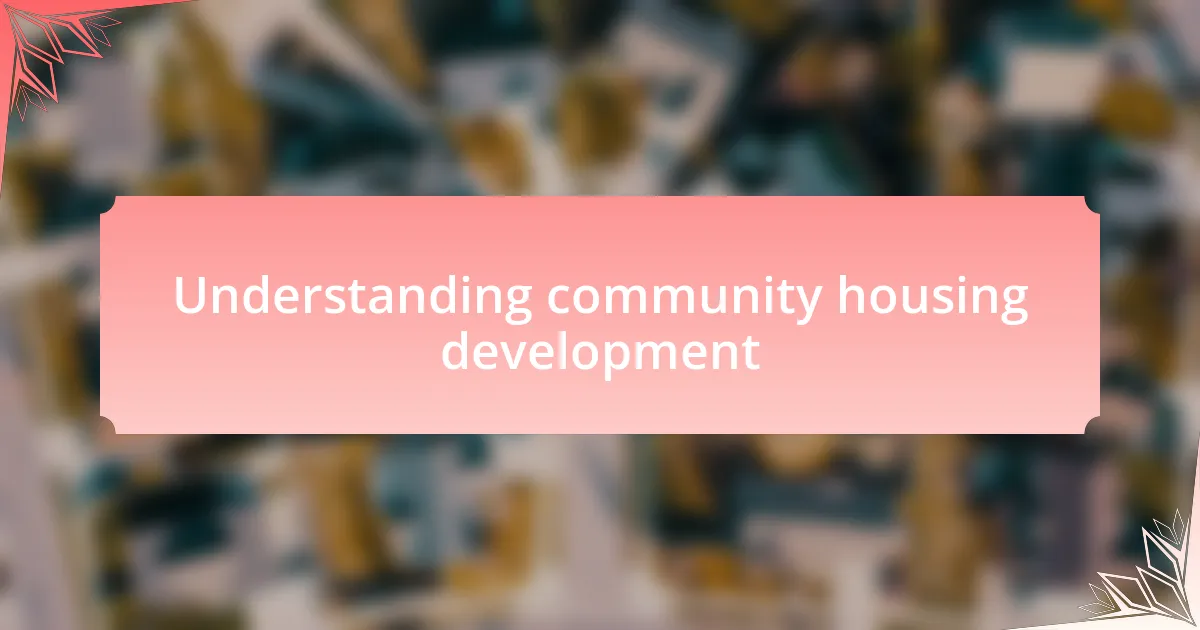
Understanding community housing development
Community housing development is about more than just creating structures; it’s about fostering connections and building vibrant neighborhoods. When I first became involved, I was struck by how essential it is to listen to the voices of those who will live in these spaces. How often do we forget to ask the community what they need? This simple act of engagement can shape projects in ways that statistics alone cannot.
I recall a project that aimed to revitalize an underused area in my city. During community meetings, emotions ran high as residents voiced their desires and concerns. Their stories—about safe play areas for children and spaces for community gatherings—opened my eyes to the profound impact that thoughtful design can have on daily lives. It was clear to me that community housing development isn’t just an architectural challenge; it’s also a responsibility to the people it serves.
Moreover, the concept of community housing goes hand in hand with sustainability and inclusivity. The principles underlying it should reflect the diversity of the population it aims to serve. As I gathered insights from different stakeholders, I learned that a truly inclusive community design considers accessibility as a priority. Have we done enough to ensure that everyone can feel connected? This ongoing question drives my approach, pushing me to advocate for spaces that welcome everyone, regardless of their backgrounds.
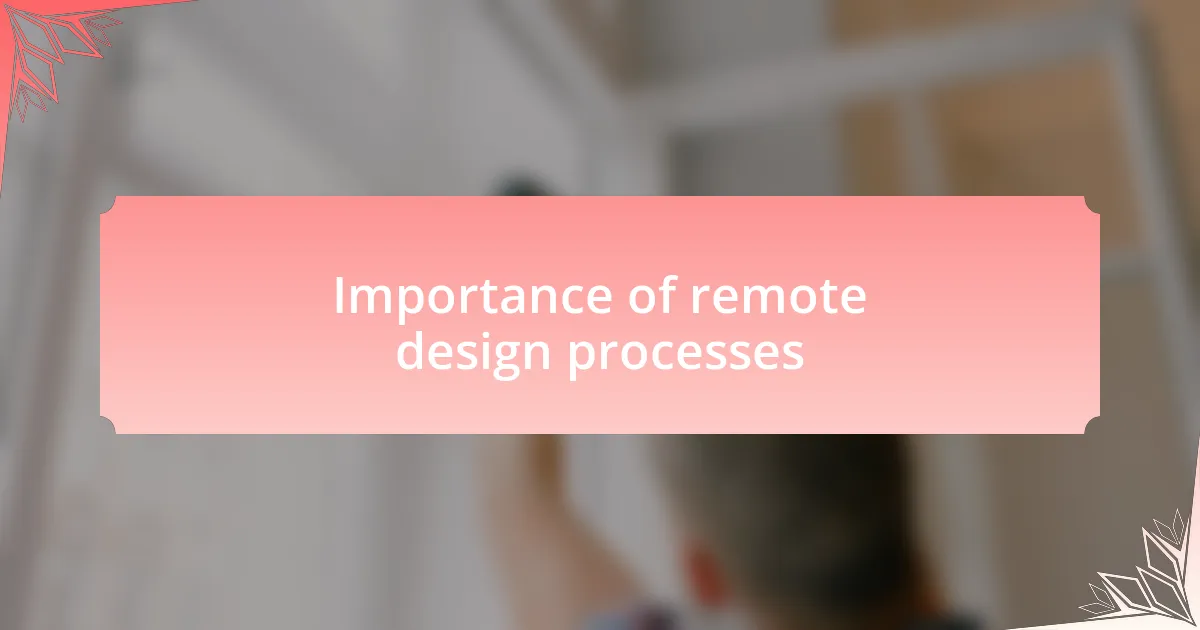
Importance of remote design processes
Embracing remote design processes has transformed how I approach my work in community housing development. For instance, I remember a recent online workshop where participants shared their thoughts on neighborhood needs from the comfort of their homes. It amazed me how this setup allowed for participation from voices that might have otherwise been sidelined, making the design process more democratic and responsive to diverse perspectives.
The flexibility of remote collaboration fosters creativity. I found it enlightening to use digital whiteboards to visualize ideas in real time during virtual brainstorming sessions. The spontaneous input from team members, coupled with instant feedback, created an electrifying atmosphere that sparked innovative solutions. Isn’t it fascinating how technology can elevate our collective imagination when we design spaces for living?
In my experience, remote design processes also cultivate continuous communication. I’ve learned to utilize various digital tools to ensure that stakeholders remain engaged throughout the project. This connection keeps the community informed and involved, which is vital. When everyone feels their opinion matters, isn’t it compelling to realize the potential impact our designs can have on shaping their world?
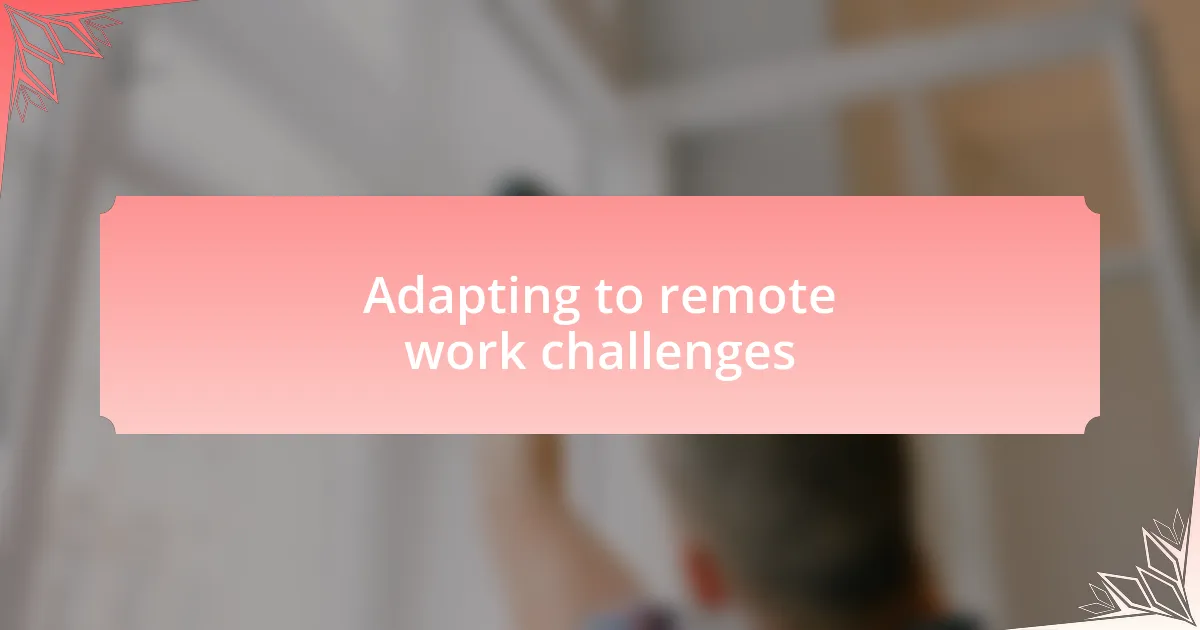
Adapting to remote work challenges
Adapting to remote work has presented its own set of challenges that I couldn’t have anticipated. For instance, I vividly recall struggling with miscommunication during early virtual meetings. Without the usual face-to-face cues, I found myself clarifying intentions more often, which pushed me to hone my communication skills—a necessary evolution in my design process.
One of the biggest hurdles has been fostering collaboration. At first, I missed the energy of a physical workspace, where ideas flowed freely among team members. I tackled this by scheduling regular check-ins, which transformed my approach. It turned out that a simple, structured agenda helped keep our virtual conversations focused and productive, almost like creating a rhythm that everyone could dance to.
Moreover, I’ve encountered moments of isolation that can seep into the creative process. I remember one late night, feeling disconnected as I stared at my screen, waiting for feedback on my designs. To combat this, I started sharing my struggles with peers more openly. This honesty not only nurtured deeper connections but also fostered a culture of support, reminding me that we’re all navigating this remote landscape together. Have you ever found solace in vulnerability within your own work environment?
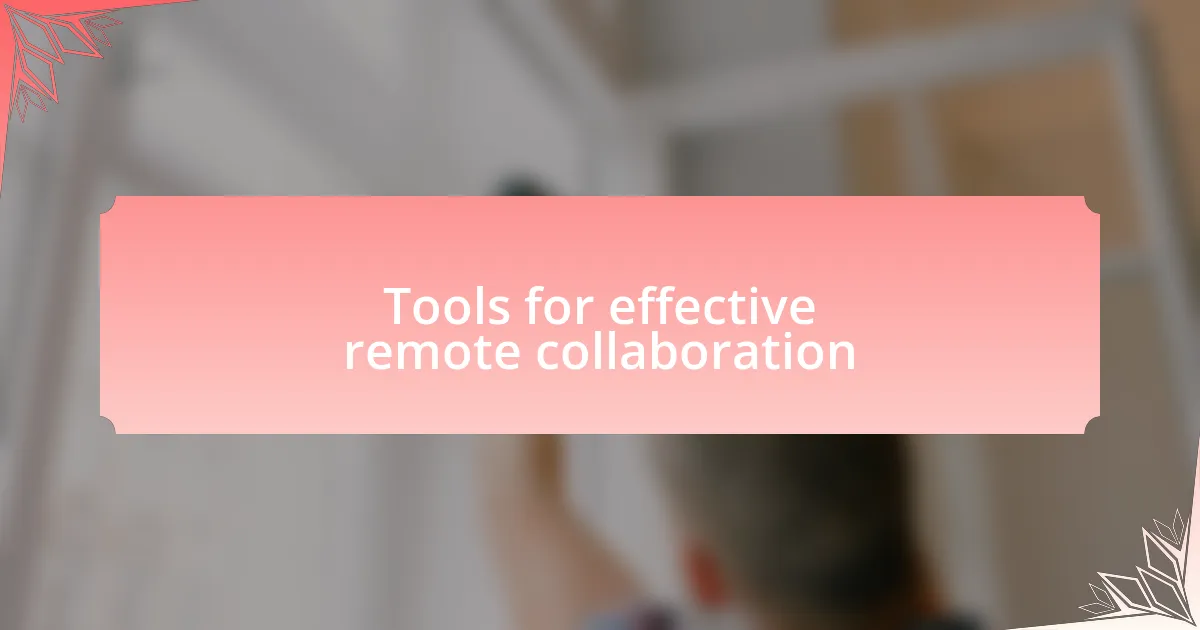
Tools for effective remote collaboration
When I set out to enhance my remote collaboration skills, I quickly discovered that the right tools would be my best allies. One of my go-to platforms has been Slack, which facilitates seamless communication. I remember the first time I used it for project updates; it felt like a virtual water cooler, where exchanging ideas became second nature, even miles apart. How has your experience with team communication tools shaped your daily workflow?
In addition, I’ve leaned heavily on collaborative design software like Figma. The real-time editing and feedback features have been game changers for me, allowing team members to contribute simultaneously. I can still recall a pivotal project where our shared brainstorming session led to a breakthrough idea that none of us would have reached alone. Isn’t it fascinating how technology can mimic those spontaneous moments of creativity we once enjoyed in person?
Lastly, I found that tools like Trello have been invaluable for project management. They provide a visual overview of tasks and deadlines, keeping everyone aligned. During one particularly intricate design project, I organized our workflow using Trello cards, which not only kept us on track but also fostered accountability among team members. It’s amazing how structuring tasks can create a sense of shared purpose, isn’t it?
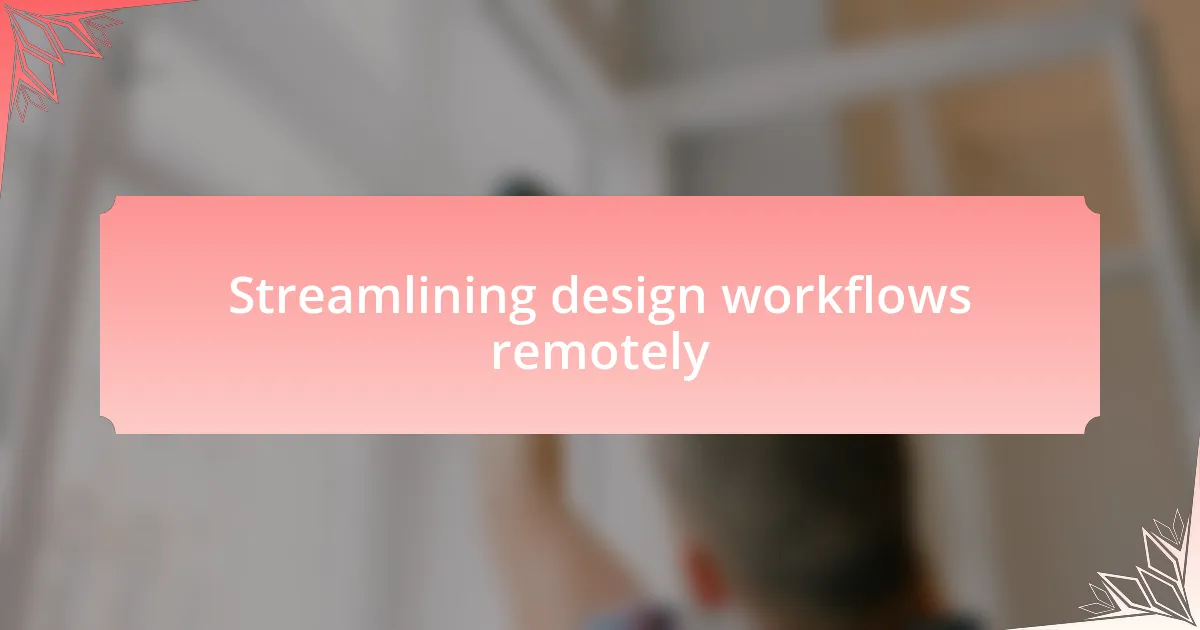
Streamlining design workflows remotely
To streamline my design workflows remotely, I found that establishing clear protocols around file management was crucial. Creating a shared cloud storage system, I ensured that every team member could access the latest design files easily. I remember the initial chaos of missing documents; having a structured folder system turned that frustration into efficiency. Have you experienced the anxiety of disorganized files in remote projects?
Another key aspect was adopting regular check-in meetings. Rather than wait for issues to arise, I began scheduling brief, focused catch-ups to address any design challenges promptly. There was one week when these check-ins turned a potential design bottleneck into a manageable discussion. It’s interesting how a simple dialogue can uncover fresh perspectives, wouldn’t you agree?
Additionally, I’ve encouraged asynchronous feedback loops, where team members can review designs on their own time. Initially, this felt a bit daunting, as direct interaction was reduced. But I discovered that giving team members the space to reflect led to more thoughtful and constructive critiques. It raises an important question: how do you balance collaboration and independent thought in your design process?
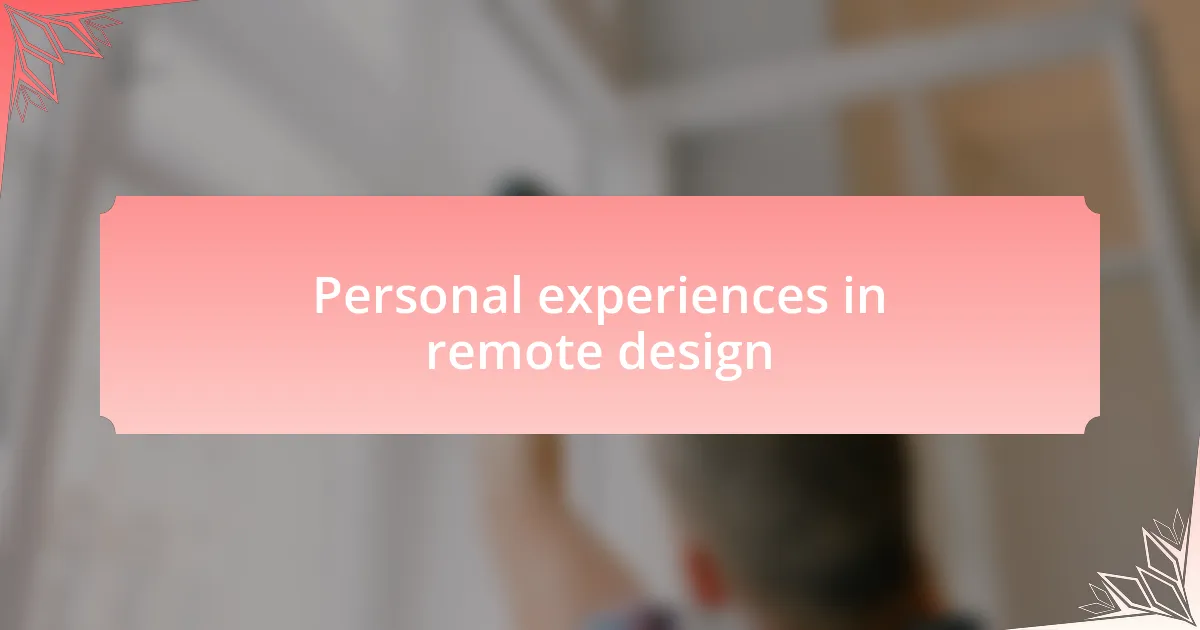
Personal experiences in remote design
One of my most vivid experiences in remote design was adapting my creative process to accommodate varying time zones. Early on, I felt isolated during late-night brainstorming sessions when my colleagues were fast asleep. It made me realize that while I enjoyed the solitude, collaboration often thrives in more synchronous environments. Have you ever felt that spark fade when your ideas aren’t bouncing back and forth in real time?
Another memorable challenge was fostering a sense of team spirit from a distance. I found that simple gestures, like sharing a morning coffee virtually, could transform our meeting dynamics. I recall one session where we all shared our home workspace setups. It not only lightened the mood but also reinforced our shared commitment to the project. Isn’t it fascinating how these small moments can strengthen bonds and enhance teamwork?
There were times when loneliness crept into my remote design life, especially during extended project phases. To combat this, I made it a point to schedule informal ‘design jams’ where we could share random ideas without the pressure of a formal meeting. These sessions not only invigorated my creativity but also reminded me why I love design in the first place. Have you found ways to spark creativity amidst the isolation of remote work?
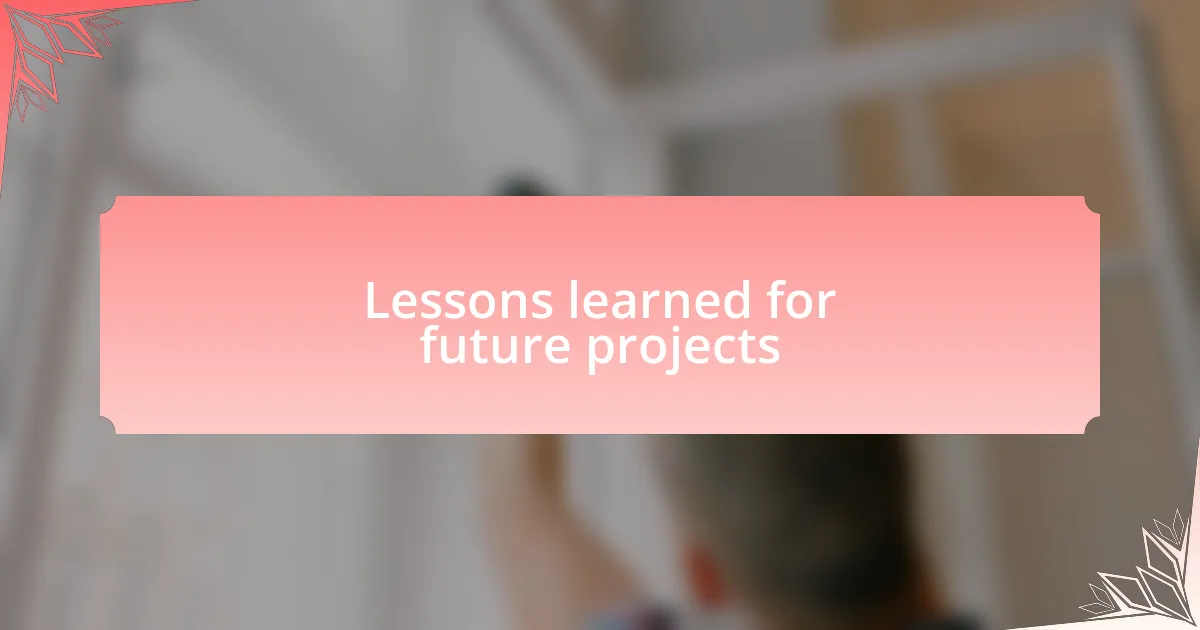
Lessons learned for future projects
One crucial lesson I learned during my shift to remote design was the importance of establishing clear communication norms. In one project, confusion over design feedback led to misalignments that cost us valuable time. It made me realize that explicit guidelines for communication—like specifying response times—could significantly reduce frustration and improve workflow. Have you encountered moments where misunderstandings could have been avoided with clearer communication?
Another takeaway has been the value of leveraging diverse tools for collaboration and creativity. In one instance, we used collaborative design software that allowed us to work on a project board in real time. It was a game changer. I felt more involved than ever, as if I were in the same room with my colleagues. The right tools can foster connections that mimic in-person collaboration. Don’t you think that investing in good software is worth it to keep the creative juices flowing?
Lastly, I found it essential to prioritize regular check-ins with team members, both for project updates and emotional support. I remember scheduling weekly ‘wellness check’ calls where we simply shared how we were doing, and those moments proved invaluable. They created a safe space to share not only project concerns but also personal challenges we faced during remote work. Isn’t it interesting how maintaining our mental well-being directly enhances our productivity and creativity?